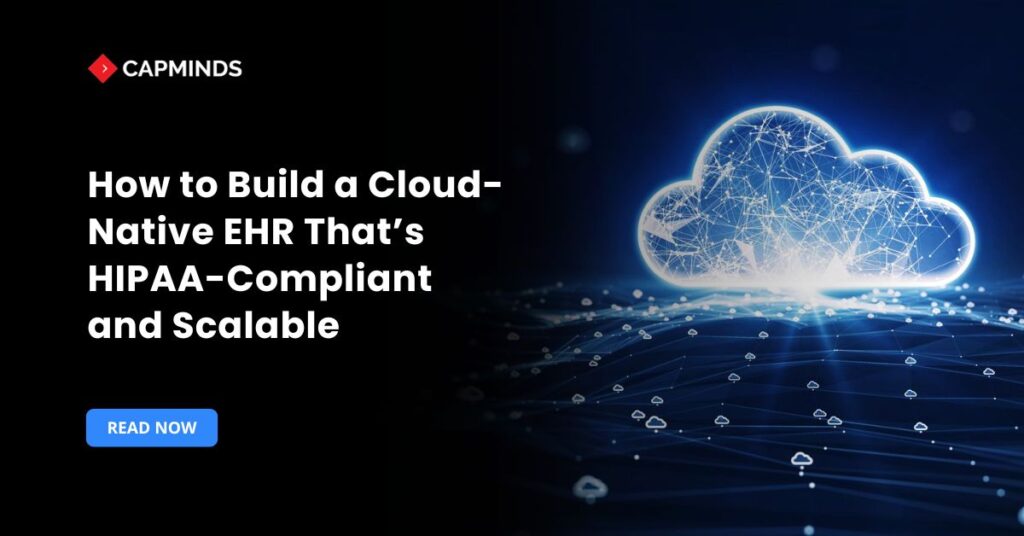How to Build a Cloud-Native EHR That’s HIPAA-Compliant and Scalable
Design must change from monolithic on-premises systems to modular, distributed services to move to a cloud-native EHR. Any function can operate as its own scalable service because contemporary EHR platforms are built on microservices and containers. This approach means modules communicate via secure APIs rather than a single huge codebase. Adopting a microservices architecture is the fundamental approach for any contemporary EHR. In practice, each service is stateless and can be scaled horizontally – meaning you add more instances of that service under load instead of beefing up a single server.
For instance, the patient-record service can automatically spin up additional containers during an unexpected spike in patient registrations without interfering with the lab results or authentication services. Its architecture separates faults so that a single service failure does not bring down the entire system, in addition to handling peak loads elastically.
Using open data interoperability standards, creating robust security measures, and preparing for elastic scalability are important architectural problems. The architecture of a cloud-native EHR should consist of a number of loosely linked microservices operating in managed or serverless containers. Each service is often packaged in a Docker container and managed by an orchestration layer. This enables rolling upgrades, automated auto-scaling, and infrastructure-as-code deployments.
Since every instance may handle any request, it is equally important to make every service stateless and fault-tolerant. This will enable you to employ round-robin load balancers to spread load evenly and swiftly replace unhealthy instances. In a well-designed system, critical middleware is deployed redundantly to avoid single points of failure.
Cloud-Native EHR Architecture
Some core cloud-native design tactics for EHR include:
Decoupling into Microservices
Use APIs, such as the Clinical Data Service, Scheduling Service, and Analytics Service, to divide the EHR into discrete components that communicate with each other. Each component can therefore develop and alter independently.
Containerization
Docker containers should be used to package each service, and Kubernetes or managed containers should be used for orchestration. Kubernetes’s built-in features—auto-scaling, self-healing, and service discovery—are crucial for cloud-native applications.
API-First Design with FHIR
Use RESTful APIs that follow the HL7 FHIR standard to share medical data. In order to guarantee that different systems “speak the same language,” FHIR provides a common data model.
For example, AWS HealthLake and Azure Health Data Services are built on top of FHIR APIs. A cloud-native EHR will typically provide FHIR endpoints for interoperability with other systems and patient apps.
Polyglot Data Storage
Match each data domain to the right storage. Important structured data (such as FHIR resources and relational patient tables) is kept in relational databases for consistency and advanced searches.
High-volume or unstructured data is kept in NoSQL/document stores or data lakes for scalability and cost-effectiveness. For example, a polyglot persistence strategy might store Patient/Observation in SQL and raw device telemetry in a distributed NoSQL store.
Event-Driven Integration
Disconnect services wherever possible, and use message queues or event streams to handle activity spikes. An EHR might publish “orders placed” or “lab results available” as events that downstream services consume. This pattern reduces tight coupling and improves elasticity – e.g. peak lab orders can queue up and be processed asynchronously.
Related: Cloud-Based EHR Vs In-House EHR: How To Choose The Best?
Core Components and Platforms
A production cloud-native EHR requires a cohesive stack of managed services and self-hosted components. Key building blocks include:
Microservices & Containers
- Independent services built in languages like Python, Java, and .NET are deployed using Docker containers.
- Each service has its own database or data storage. Kubernetes manages scheduling, networking, and auto-scaling.
- For example, a Kubernetes cluster with separate namespaces for “authentication,” “clinical-data,” and so on ensures isolation and performance control.
API Layer
- An FHIR server or secure API gateway. Several teams use managed FHIR servers to speed up development.
- For instance, AWS HealthLake provides a fully managed FHIR API that is HIPAA-compliant and capable of ingesting and storing patient details at petabyte scale.
- Similar managed FHIR and DICOM servers designed for PHI applications are available through Azure’s Health Data Services.
- The Healthcare API on Google Cloud facilitates interaction with lab systems and image archives by supporting FHIR, HL7v2, and DICOM standards.
Data Storage
- Databases, object stores, and data warehouses for analytics and PHI.
- Transactional FHIR records are handled by a relational database.
- NoSQL databases (DynamoDB, Cosmos DB) are used to store unstructured data or high-throughput telemetry.
- Encrypted object storage is used to store large files.
- Analytics and warehousing use services like AWS Redshift, Azure Synapse, or GCP BigQuery.
Compute & Orchestration
- Serverless functions or container orchestration services are used to run the code.
- Many healthcare clouds are designed with Kubernetes at their core because it inherently supports HIPAA security features like RBAC, encryption integration, and audit logging.
- For example, Kubernetes can enforce SSL/TLS for intra-cluster traffic and store logs centrally for compliance checks.
Monitoring & Logging
- CloudWatch/CloudTrail on AWS, Azure Monitor/Log Analytics, and Google Cloud Monitoring/Logging are examples of observability platforms.
- These collect metrics and logs.
- For instance, AWS CloudTrail creates an unchangeable audit trail of each API call performed on AWS services for HIPAA audits.
- An EHR system will incorporate these services or third-party tools to track service health, offer anomaly alerts, and store logs.
Interconnect & Networking
- Create a secure VPC or VNet with private subnets for PHI workloads.
- API gateways provide access to FHIR endpoints.
- The EHR is typically spread over multiple regions or availability zones for fault tolerance.
- Internal traffic is encrypted and flows through load balancers that distribute requests across containers, automatically removing failing nodes from rotation.
For instance, the EHR of a hospital may be divided into microservices like Patient-Service, Orders-Service, Billing-Service, etc. The Patient-Service is supported by an Amazon Aurora cluster for storage and operates on Kubernetes with three pods. An Application Load Balancer is used to route traffic to /FHIR/Patient. Any pod statelessly handles each new user request. Kubernetes may automatically spin up more pods to manage the load during peak hours. PHI is safeguarded while at rest thanks to AWS KMS’s management of the encryption keys for the database and S3 buckets.
Security and HIPAA Compliance
Security is paramount in any EHR. Every piece of protected health information (PHI) needs to be auditable, accessible, and encrypted. Every cloud provider provides a range of features and services that are compliant with HIPAA:
BAA and Eligible Services
First, get your cloud provider to sign a Business Associate Agreement. AWS, Azure, and Google all sign BAAs covering HIPAA-eligible services and function as Business Associates under the law. Only designated services can store PHI; for example, AWS publishes a list of HIPAA-eligible services.
Azure’s Health Data Services and Cosmos DB are HIPAA-eligible and HITRUST CSF certified. Google Cloud’s BAA covers its entire infrastructure, not just isolated “HIPAA zones,” meaning you can use any region without losing compliance protections. Make sure you only activate HIPAA-compliant services for PHI at all times.
Encryption
Encrypt ePHI while it’s in transit and at rest. AES-256 or above should be used for cloud storage. For instance, managed encryption keys that automatically encrypt S3, EBS, and RDS data at rest are provided by the AWS Key Management Service. “AWS KMS enables encryption of data both at rest and in transit, ensuring PHI is securely protected,” according to CloudTech.
In actuality, utilise TLS for all API endpoints and service-to-service communication, and activate server-side encryption on all buckets and disks. For respective systems, Google Cloud KMS and Azure Key Vault provide comparable key management. It is essential to have strong key management policies.
Access Control
Implement the principle of least privilege. Use IAM roles, policies, and directory services to ensure only authorised users and services can access PHI. Carefully define responsibilities both within applications and at the cloud level. Kubernetes RBAC, for instance, can limit who can view or alter cluster data.
For administrator access, multi-factor authentication is always required. Every account that has access to PHI should be treated as high-value, and you should audit who logs in and from where.
Audit Logging and Monitoring
Comprehensive audit trails are required by the HIPAA Security Rule. Enable comprehensive logging at all levels: AWS CloudTrail, Google Cloud Audit Logs, or Azure Monitor Logs. The EHR program itself should log access to records, and these logs should be immutable. Use a managed logging solution, such as SIEM, to gather logs and issue alerts for anomalies.
For example, you may set up CloudWatch Alarms to alert you to surges in unsuccessful login attempts and transmit audit reports into CloudWatch reports or an ELK stack for analysis. As one guide advises, “enabling detailed logging on critical services … and setting up alarms… helps detect and respond to suspicious activity proactively”. Keep audit logs safe from manipulation for the duration required by HIPAA, which is usually six years.
Network and Infrastructure Security
For your EHR, create a private virtual network. Use security groups and network ACLs to divide up traffic. Any service endpoints should only be accessible through secure gateways or private networks. Use a VPN or AWS Direct Connect if you must connect to on-site data centres.
Regularly do penetration testing and vulnerability scans. Cloud providers and third-party tools can routinely assess your configuration against HIPAA benchmarks.
Disaster Recovery (DR) and Contingency
A contingency plan that includes DR is required by HIPAA. This is made simple by the redundancy built into cloud platforms. For greater robustness, use multi-region active-passive failover; at the very least, spread important services over multiple availability zones.
Permit cross-region replication of databases and S3 buckets, for example. Regularly back up ePHI to geographically separate locations. Many vendors offer “always-on” backup to S3 or Glacier, which can quickly restore to the last written state if the primary data is inaccessible.
As the HIPAA Journal recommends, disaster recovery services often keep backups “up to the point when data access was lost” and maintain redundant servers in multiple data centres. To guarantee that the system fails over seamlessly in a real outage and maintains a 99.999% uptime goal, regularly test your failover strategies and run mock drills. In this way, even in the case of a catastrophic data centre failure, clinicians won’t be left without records.
Cloud Platforms and Healthcare Services
Each major cloud offers specialised services for healthcare data:
Amazon Web Services (AWS)
AWS is a common choice for EHR due to its extensive service catalogue.
- AWS offers healthcare-specific services in addition to its basic services.
- Clinical and claims data are stored in an FHIR-native data lake via AWS HealthLake, a fully managed HIPAA-eligible service.
- It can automatically normalise disparate medical data (clinical notes, lab results, images) into FHIR format and let you query it with built-in NLP.
- HealthLake integrates with Athena/Redshift for analytics and SageMaker for ML.
For pure EHR workloads, AWS also offers Amazon HealthImaging and a range of HIPAA-eligible databases. AWS’s compliance documentation notes that using these managed services under a signed BAA “enables customers to address the HIPAA requirements” while gaining the cloud’s scalability.
Microsoft Azure
Azure’s Health Data Services is a suite built specifically for PHI. It has interfaces to analytics programs for real-time insights, as well as managed FHIR and DICOM servers.
An enterprise-grade FHIR server with integrated security and availability SLAs is offered by Azure API for FHIR, which is now a part of Health Data Services. Additionally, Azure provides a managed environment that complies with HIPAA regulations as well as HIPAA-eligible databases.
Notably, Azure Health Data Services is HITRUST CSF certified and explicitly designed to meet HIPAA and GDPR requirements. In practice, an Azure-based EHR might use AKS for microservices, Azure SQL for patient records, Azure Blob for images, and Azure AD for identity. Azure’s native tools, like Monitor and Security Centre, provide compliance dashboards. Azure will incorporate the essential HIPAA protections into its services and sign the relevant BAA.
Google Cloud Platform (GCP)
For FHIR, HL7v2, and DICOM, Google’s Cloud Healthcare API provides a fully managed service that complies with HIPAA regulations. It lets you ingest data into separate FHIR/DICOM “datastores” inside Google Cloud projects. All data is encrypted at rest, and IAM controls access.
The Healthcare API supports bulk import/export to BigQuery for analytics. According to Google, this API can handle “thousands of requests per second” on Google’s redundant infrastructure – ideal for large health systems. Google Cloud also offers Anthos and GKE for Kubernetes, Pub/Sub for messaging, and Bigtable/Firestore for high-throughput storage.
Importantly, Google’s HIPAA BAA covers its entire global infrastructure and does not charge extra for compliance – you get the same pricing as non-healthcare workloads. Cloud Monitoring, Cloud Logging, and Chronicle (SIEM) can be used for HIPAA-compliant audit trails.
Regardless of provider, the strategy is similar: choose managed, HIPAA-eligible building blocks; sign the BAA; and build additional security layers (VPC isolation, encryption) as needed.
For example, a healthcare CIO might choose AWS for its mature HealthLake ecosystem, or Azure for its strong FHIR and regulatory tooling, or GCP for its data analytics pipeline – but in each case, the underlying patterns (microservices, Kubernetes, encrypted data stores) remain consistent.
Scalability and Interoperability
Scaling to meet demand
A cloud-native EHR must handle unpredictable loads without lag. This means horizontal scaling is baked into the design.
Each microservice runs in an auto-scaling group or Kubernetes ReplicaSet. When CPU/memory thresholds are met, new pods spawn automatically.
- For instance, putting each service behind an “elastic auto-scaling group or container orchestration platform, so that extra compute nodes are added automatically during peaks”.
- Databases are scaled with read replicas and sharding: a primary RDS instance handles writes, and multiple replicas serve read-heavy workloads.
- Caching layers are used to accelerate read-mostly data.
- Load balancers distribute traffic evenly across zones; any unhealthy instances are dropped automatically, preventing cascade failures.
- In effect, the system behaves like a highway that can open extra lanes on demand, and Kubernetes is the traffic controller that reroutes around congestion.
FHIR and interoperability
Modern EHRs must integrate with pharmacies, labs, other hospitals, and patient apps. The HL7 FHIR standard is key: it defines common data formats and RESTful APIs for health data. By storing data in FHIR format, an EHR gains plug-and-play interoperability.
As AWS HealthLake’s benefits state, it “Stores patient medical history from multiple sources in a normalised FHIR format and leverages FHIR APIs to build applications and patient 360° views”. Equally, Azure and Google healthcare offerings fully support FHIR.
In practice, your microservices will consume and produce FHIR JSON resources. For example, when the Scheduling service books an appointment, it might POST a Slot and Appointment resource to the FHIR store, and other services (notifications, billing) can subscribe to those events.
APIs can also expose standard endpoints for patient-facing apps. Using common standards avoids custom integrations, making life easier for developers of downstream applications.
Horizontal Scaling with Kubernetes
Kubernetes itself is integral to scalability. It manages resource allocation across nodes, can perform auto-scaling at the cluster level, and can run across multiple zones for high availability. Many teams set up horizontal pod autoscalers that monitor CPU or request latency and spin up pods as needed.
For example, a telehealth video gateway might run in a Kubernetes deployment that scales out when call volume rises. Kubernetes also supports multi-region clusters (with appropriate network setup) for disaster tolerance. Crucially, Kubernetes’s security features help meet HIPAA requirements.
For instance, Kubernetes can enforce Role-Based Access Control, ensuring that only the “clinician” service account can read patient records, thereby satisfying HIPAA’s “minimum necessary” rule.
Related: Custom EHR Architecture in 2026: How to Build for Scalability, Interoperability, and Future Regulations
Cloud-Native EHR Implementation Services – Power Your Transformation with CapMinds
Building a HIPAA-compliant, cloud-native EHR requires deep engineering, secure architecture design, and real healthcare expertise.
This is exactly where CapMinds Cloud-Native EHR Services accelerate your journey. We deliver end-to-end digital health tech solutions that help organisations modernise legacy EHRs, migrate to microservices, and build scalable, compliant cloud ecosystems across AWS, Azure, and GCP.
At CapMinds, we bring everything you need to design, deploy, optimise, and maintain a cloud-native EHR—no matter your size. Our Cloud-Native EHR Services include:
- Microservices & Container Architecture Design (Docker, Kubernetes)
- HIPAA-Compliant Cloud Setup (AWS, Azure, GCP)
- HL7 & FHIR API Integration
- EHR Data Migration
- Event-Driven Interoperability Frameworks
- Security Hardening, IAM, Encryption & Audit Logging
- DR/Backup Strategy, Multi-Region Resilience Engineering
With over a decade of expertise in healthcare engineering, CapMinds helps you modernise workflows, strengthen compliance, and scale without limits.
Whether you’re transforming an existing EHR or building a new cloud-native platform, we deliver the complete ecosystem, architecture, interoperability, automation, analytics, and more.
Ready to build a secure, scalable, cloud-native EHR?
Partner with CapMinds and accelerate your modernisation roadmap today.




